The Taux Directeur, or key interest rate, is the cornerstone of monetary policy in Canada. Managed by the Bank of Canada (BoC), it influences almost every financial decision in the economy, from mortgages to corporate investments, and plays a critical role in controlling inflation, stabilizing the currency, and supporting sustainable economic growth.
Contents
What is the Taux Directeur?
The Taux Directeur is the interest rate at which the Bank of Canada lends money to commercial banks or accepts deposits from them. This rate forms the basis for most other interest rates in the economy, including:
-
Personal loans and credit cards
-
Variable-rate mortgages
-
Business loans
-
Government and corporate bonds
It is also a key signal of the BoC’s monetary policy stance—whether it wants to stimulate growth or curb inflation.
Mechanism of the Taux Directeur
-
Influence on Commercial Banks:
Banks adjust their lending and deposit rates based on the BoC’s rate. A higher Taux Directeur increases the cost of borrowing, while a lower rate makes loans cheaper. -
Impact on Consumer Behavior:
When rates rise, Canadians tend to save more and borrow less, reducing consumption. Conversely, lower rates encourage spending and borrowing, which boosts economic activity. -
Effect on Inflation:
Inflation is sensitive to borrowing costs. By raising the Taux Directeur, the BoC can reduce money supply in the economy, helping control price increases. Lowering rates can increase spending, sometimes boosting inflation if it is too low. -
Currency and Investment Flows:
A higher Taux Directeur can strengthen the Canadian dollar as international investors seek higher returns. Conversely, lower rates may weaken the currency but encourage domestic investment and exports.
Historical Perspective in Canada
The Bank of Canada has adjusted the Taux Directeur in response to various economic conditions:
-
1980s: Extremely high rates (over 20%) to control hyperinflation.
-
2008 Financial Crisis: Rates were slashed to near zero to stimulate the economy.
-
2020 Pandemic: Emergency cuts to 0.25% to support households and businesses.
-
2022-2024: Gradual rate hikes to combat rising inflation after COVID-19 recovery.
Understanding these historical trends is essential for predicting future economic conditions in Canada.
Effects on Canadian Consumers
-
Mortgages:
-
Variable-rate mortgages directly respond to Taux Directeur changes.
-
Fixed-rate mortgages are indirectly affected as bond yields and lending costs adjust.
-
-
Loans and Credit Cards:
Borrowing costs rise when the rate increases and drop when the rate decreases. -
Savings Accounts:
Higher rates increase returns on savings and term deposits, while lower rates reduce them.
Effects on Businesses and Investment
-
Capital Costs: Higher rates increase borrowing costs for business expansion.
-
Investment Decisions: Low rates encourage companies to invest in new projects or hire more staff.
-
Stock Market: Interest rate hikes can reduce equity valuations as borrowing costs rise, while lower rates often boost stock prices.
The Bank of Canada’s Policy Approach
The BoC sets the Taux Directeur with three primary goals:
-
Inflation Control: Targeting around 2% inflation to maintain price stability.
-
Economic Growth: Supporting sustainable GDP growth.
-
Employment Stability: Ensuring low unemployment without overheating the economy.
The BoC usually reviews the rate eight times per year but can act sooner in response to economic shocks.
Taux Directeur and the Canadian Dollar
The Taux Directeur strongly influences foreign exchange rates. Investors are attracted to countries with higher interest rates, increasing demand for the Canadian dollar. Conversely, lower rates may weaken the currency but make Canadian exports more competitive internationally.
FAQ
Q1: How often does the Bank of Canada change the Taux Directeur?
The BoC typically reviews it eight times a year, but emergency adjustments can occur during economic crises.
Q2: How does the Taux Directeur affect mortgages in Canada?
Variable-rate mortgage payments fluctuate with changes in the BoC rate. Fixed-rate mortgages are affected indirectly through broader market interest rate trends.
Q3: What is the difference between Taux Directeur and prime lending rates?
The prime rate is the interest rate banks offer to their most creditworthy customers. It is influenced by the Taux Directeur but set individually by each bank.
Q4: Can Taux Directeur affect inflation?
Yes. Increasing the rate typically reduces spending and borrowing, slowing inflation, while lowering the rate can boost economic activity and potentially increase inflation.
Q5: Why does the Bank of Canada change the rate?
To balance economic growth, inflation, and employment. Rate hikes often combat inflation, while cuts stimulate the economy during slowdowns.
Q6: How does it impact the Canadian dollar?
Higher rates attract foreign investment, strengthening the Canadian dollar. Lower rates can weaken the currency but support exports and domestic consumption.
Q7: Does Taux Directeur affect stock markets?
Yes. Higher rates increase borrowing costs, which can negatively impact stock prices. Lower rates reduce capital costs, often boosting equity markets.
